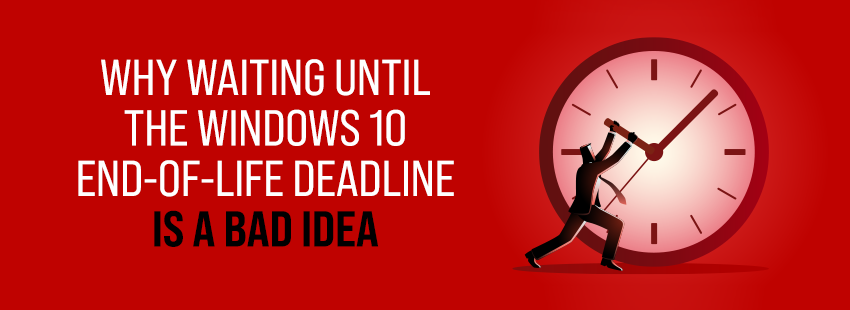We Help Businesses Thrive.
Peace of Mind is closer than you think.
Let's have a quick chat.

The Windows 10 end-of-life deadline is fast approaching. Delaying the upgrade can lead to several issues, including hardware shortages, software compatibility problems, and missing out on the new AI enhancements available in Windows 11. Upgrading early ensures you can avoid unnecessary disruptions and benefit from cutting-edge technology.
Waiting until the last minute can increase your expenses. Businesses relying on line-of-business (LOB) applications may face compatibility issues, especially if these applications aren’t cloud-based. To run smoothly on Windows 11, these applications may need updates, custom patches, or new versions altogether. Delaying your upgrade could lead to rushed and costly adjustments.
Moreover, outdated hardware might struggle to run Windows 11, particularly when considering the new AI enhancements the operating system offers. This could mean replacing devices that aren’t equipped to handle the enhanced performance demands, adding to your upgrade costs. Upgrading early allows you to plan for these expenses and spread them out over time.
Windows 11 introduces significant AI enhancements, making it smarter and more intuitive than ever. Features like AI-driven suggestions for better productivity, improved security through machine learning, and enhanced voice recognition tools are built into the system. These tools can help your business streamline operations, automate tasks, and improve collaboration. However, older machines may not be able to take full advantage of these features.
Upgrading your hardware now ensures you can leverage Windows 11’s AI capabilities to boost productivity. Devices powered by the latest processors, designed to run AI applications, will deliver faster performance and a smoother user experience. By waiting, you risk missing out on these transformative improvements, which can give your business a competitive edge.
Hardware shortages have been a recurring problem over the last few years, with global supply chain disruptions affecting the availability of essential components. As the Windows 10 end-of-life deadline draws nearer, the rush to upgrade will only increase demand for new hardware. If you delay your upgrade, you could find yourself waiting for weeks or even months to receive the necessary devices.
Your business may require new desktops, laptops, or servers capable of running Windows 11 and its AI-driven tools. If you wait too long, you risk being stuck in a backlog of orders, forcing you to run outdated systems past the Windows 10 end-of-life deadline. This can lead to reduced productivity and missed opportunities for growth.
Businesses often rely on specialized LOB applications customized to run on older operating systems. These applications may not be compatible with Windows 11, making upgrading a challenge if you wait until the last minute. Some applications might require updates or replacement, which could take months to develop and test.
By planning your transition early, you can test your LOB applications on Windows 11, resolve compatibility issues, and ensure a smooth upgrade. Waiting too long increases the risk of your applications breaking or causing disruptions, especially if they haven’t been updated for AI integration and other modern features.
Once the Windows 10 end-of-life deadline passes, Microsoft will stop providing security updates. Without these updates, your business will be exposed to cyber threats and vulnerabilities. Hackers often target systems running outdated operating systems, and a lack of security patches will leave your data at risk.
Upgrading to Windows 11 provides improved security and AI-driven security enhancements. These include features that detect potential threats in real-time, offering stronger protection against malware and ransomware. Businesses that delay their upgrade risk leaving themselves vulnerable to costly data breaches or compliance violations.
Upgrading to a new operating system can be complex. If you wait until the last minute, your IT team could find themselves overwhelmed, trying to implement upgrades on a tight deadline. This can lead to rushed decision-making, missed compatibility issues, and prolonged downtime.
Planning your upgrade early allows for thorough testing, proper implementation of AI features, and the opportunity to resolve hardware and software issues before they impact your business. By acting now, you reduce the risk of errors and ensure your transition to Windows 11 is smooth and efficient.
Waiting until the Windows 10 end-of-life deadline will only create more problems. Hardware shortages, compatibility issues, and missing out on AI-powered improvements will increase stress and costs. Upgrading early ensures you can secure the right hardware, avoid unexpected expenses, and leverage Windows 11’s powerful new tools.
Windows 11’s AI features will modernize your operations, enhance productivity, and improve collaboration. The sooner you upgrade, the sooner your business can start taking advantage of these innovations. Don’t wait for the deadline. Planning will save you money, time, and future frustration.
Waiting until the Windows 10 end-of-life deadline is a risk that is not worth taking. Delaying will increase hardware shortages, compatibility problems with LOB applications, and security vulnerabilities. Additionally, missing out on the AI enhancements in Windows 11 could limit your business’s productivity and innovation. By upgrading now, you ensure a seamless transition and gain the benefits of next-generation technology.

Peace of Mind is closer than you think.
Let's have a quick chat.
Schedule a 15-minute introductory call with our support experts and we'll see what we can do for you.